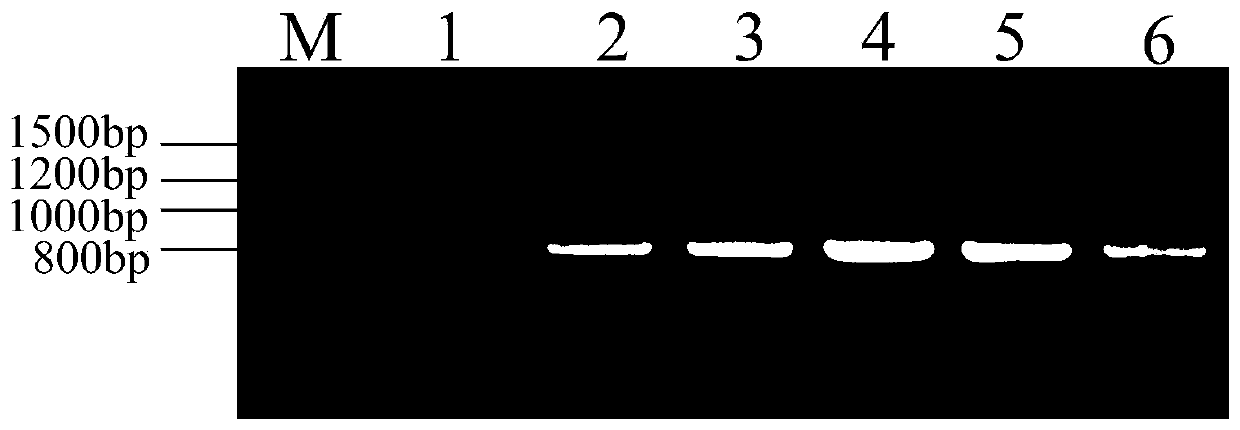A recombinant Mortierella alpina overexpressing ω-3 desaturase derived from Phytophthora parasitica, its construction method and application
A technology of Mortierella alpina and Phytophthora parasitica applied in the field of genetic engineering
- Summary
- Abstract
- Description
- Claims
- Application Information
AI Technical Summary
Problems solved by technology
Method used
Image
Examples
Embodiment 1
[0050] Example 1: Enzyme cleavage reaction
[0051] According to the codon usage preference of Mortierella alpina, the nucleotide sequence of the ω-3 desaturase gene (Genbank accession No: XM_008906963) derived from the natural Phytophthora parasitica was codon-optimized, and the optimized gene was artificially synthesized Sequence oPpFADS17, as shown in SEQ No.1 and 2. Then it was connected with PUC57 vector to obtain PUC57-oPpFADS17.
[0052] Under the condition of 37°C, first digest the plasmid PUC57-oPpFADS17 and the vector pBIG2-ura5s-ITs fragment overnight with the restriction endonuclease Hind III. The Hind III digestion system (100 μL) is: 2 μL Hind III-HF, 30 μL plasmid or Carrier, 10 μL Cutsmart Buffer, 58 μL deionized water, incubated at 37°C for 12h.
[0053] Among them, the vector pBIG2-ura5s-Its is directly obtained according to the Chinese patent application CN201310524221.4.
[0054]The HPH expression unit was obtained from the pD4 plasmid by PCR, and the HP...
Embodiment 2
[0057] Example 2: Ligation reaction
[0058] The digested and purified ω-3 desaturase gene fragment oPpFADS17 was ligated with the vector pBIG2-ura5s-ITs with T4 ligase, and ligated at 4°C for 12 hours to obtain the recombinant expression vector pBIG2-ura5s-oPpFADS17. The ligation system is (10 μL): 2 μL of the digested fragment of the target gene, 3 μL of the digested fragment of the vector, 1 μL of ligase buffer, 1 μL of T4 ligase, 3 μL of sterile water, and ligate at 4°C for 12 hours.
[0059] The ligation product was transformed into Escherichia coli TOP10 competent cells, and the transformation method was as follows:
[0060] (1) Take 100 μL of competent cells in a sterile state, add 1-2 μL of the ligation product, and mix by blowing and aspiration.
[0061] ⑵ Transfer the mixed competent cells into the pre-cooled electroporation cuvette to avoid the generation of air bubbles.
[0062] ⑶Put the electric cup into the Bio-Rad electroporation instrument, adjust to the appr...
Embodiment 3
[0068] Example 3: Agrobacterium tumefaciens-mediated transformation of Mortierella alpina
[0069] On the basis of the existing domestic and foreign literature reports on the transformation method of Agrobacterium tumefaciens, appropriate optimization adjustments were made, as follows:
[0070] (1) Agrobacterium tumefaciens C58C1 containing the plasmid pBIG2-ura5s-oPpFADS17 stored at -80°C was streaked on a YEP solid medium plate containing 100 μg / mL rifampicin and 100 μg / mL kanamycin. Incubate at 28°C for 48 hours in the dark.
[0071] (2) Pick a single clone and inoculate it into 20 mL of liquid YEP medium containing 100 μg / mL rifampicin and 100 μg / mL kanamycin at 28°C, 200 rpm, and incubate in the dark for 24-48 hours.
[0072] (3) Centrifuge at 4000×g for 5 minutes to collect the bacteria, and discard the supernatant. Add 5mL IM medium to resuspend the bacteria, centrifuge at 4000×g for 5min, and discard the supernatant. Add 2mL IM medium to resuspend the bacteria.
[...
PUM
 Login to View More
Login to View More Abstract
Description
Claims
Application Information
 Login to View More
Login to View More - R&D
- Intellectual Property
- Life Sciences
- Materials
- Tech Scout
- Unparalleled Data Quality
- Higher Quality Content
- 60% Fewer Hallucinations
Browse by: Latest US Patents, China's latest patents, Technical Efficacy Thesaurus, Application Domain, Technology Topic, Popular Technical Reports.
© 2025 PatSnap. All rights reserved.Legal|Privacy policy|Modern Slavery Act Transparency Statement|Sitemap|About US| Contact US: help@patsnap.com



